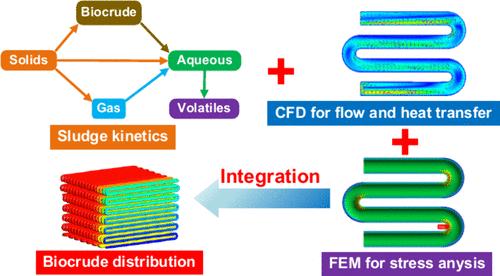连续反应器中污泥热液液化的数值模拟:动力学、流体动力学和应力分析的集成
IF 3.9
3区 工程技术
Q2 ENGINEERING, CHEMICAL
引用次数: 0
摘要
连续反应器是商业热液液化系统的核心组成部分,可以从污泥中生产高容量生物原油。为了优化反应器配置和操作条件,将污泥HTL动力学与计算流体力学和有限元方法相结合。利用该模型研究了生物原油产量、温度和应力的分布。在长度为0.5 m、温度为325℃、内径为20 mm、进口速度为0.0009 m·s-1的上流式蛇形反应器中,生物原油产率最高,为34.39 wt %。在蛇形反应器中观察到弯曲处的应力集中。将弯曲直径从14 mm增加到24 mm,最大等效应力从136.22 MPa降低到113.86 MPa,允许使用廉价的不锈钢作为反应器材料。耦合模型还为优化中试规模反应器的长度提供了见解。本文章由计算机程序翻译,如有差异,请以英文原文为准。

Numerical Simulation of Hydrothermal Liquefaction of Sludge in Continuous Reactors: Integration of Kinetics, Fluid Dynamics, and Stress Analyses
Continuous reactors serve as a core component in commercial hydrothermal liquefaction systems, enabling high-capacity biocrude production from sludge. To optimize the reactor configuration and operation conditions, HTL kinetics of sludge were coupled with computational fluid dynamics and finite element methods. The proposed model was used to explore the distributions of biocrude yield, temperature, and stress. With a total length of 0.5 m, the upward-flow serpentine reactor, 325 °C, an inner diameter of 20 mm, and an inlet velocity of 0.0009 m·s–1 provided the highest biocrude yield of 34.39 wt %. Stress concentrations at the bends were observed in the serpentine reactor. Increasing the bending diameter from 14 to 24 mm reduced the maximum equivalent stress from 136.22 to 113.86 MPa, allowing the application of inexpensive stainless steel as the reactor material. The coupled model also provides insights into optimizing the length of a pilot-scale reactor.
求助全文
通过发布文献求助,成功后即可免费获取论文全文。
去求助
来源期刊

Industrial & Engineering Chemistry Research
工程技术-工程:化工
CiteScore
7.40
自引率
7.10%
发文量
1467
审稿时长
2.8 months
期刊介绍:
ndustrial & Engineering Chemistry, with variations in title and format, has been published since 1909 by the American Chemical Society. Industrial & Engineering Chemistry Research is a weekly publication that reports industrial and academic research in the broad fields of applied chemistry and chemical engineering with special focus on fundamentals, processes, and products.
 求助内容:
求助内容: 应助结果提醒方式:
应助结果提醒方式:


